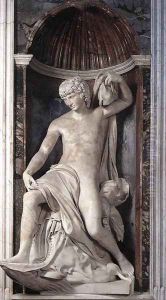Lorenzetto Paintings
Lorenzo Lotti, known as Lorenzetto, was born in 1490 in Florence, Italy. He was an important figure in the High Renaissance, a movement that marked the peak of the visual arts in the Italian Renaissance. Lorenzetto was both a sculptor and an architect, showcasing the versatility of Renaissance artists who often mastered multiple disciplines. His work is characterized by the harmonious blend of classical forms with the emerging dynamism that would later define the Baroque period.
Lorenzetto's early training is not well-documented, but it is known that he moved to Rome in his youth, where he became a pupil and collaborator of the renowned artist Raphael. Under Raphael's guidance, Lorenzetto embarked on several significant projects, which helped him develop a distinct style that combined robust sculptural elements with a fine sense of detail and composition. One of his most notable works from this period is the tomb of Raphael in the Pantheon in Rome, for which Lorenzetto sculpted the statue of the Madonna del Sasso, a testament to his skill in creating emotionally resonant religious imagery.
After Raphael's death in 1520, Lorenzetto continued to work in Rome, where he became involved in architectural projects as well. He was associated with the design and construction of several buildings and chapels, demonstrating his ability to translate the principles of Renaissance art into the architectural realm. Despite facing competition from other prominent artists and architects of the time, Lorenzetto maintained a reputation for the quality and innovativeness of his work.
Lorenzetto's influence extended beyond his lifetime, contributing to the transition towards the Baroque style. Although not as widely recognized as some of his contemporaries, his work remains an important part of the study of Renaissance art, reflecting the period's ideals of beauty, harmony, and proportion. Lorenzetto died in 1541 in Rome, leaving behind a legacy that continues to be appreciated for its contribution to the evolution of Western art. His works are preserved in various churches and museums, serving as a testament to his artistic achievements and the enduring appeal of Renaissance art.

